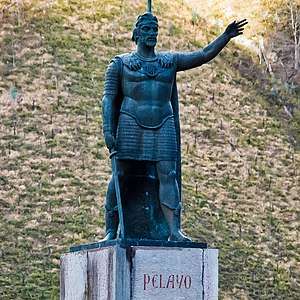718
Year 718 (DCCXVIII) was a common year starting on Saturday (link will display the full calendar) of the Julian calendar. The denomination 718 for this year has been used since the early medieval period, when the Anno Domini calendar era became the prevalent method in Europe for naming years.
| Millennium: | 1st millennium |
|---|---|
| Centuries: | |
| Decades: | |
| Years: |
|
| 718 by topic |
|---|
| Leaders |
| Categories |
|
| Gregorian calendar | 718 DCCXVIII |
| Ab urbe condita | 1471 |
| Armenian calendar | 167 ԹՎ ՃԿԷ |
| Assyrian calendar | 5468 |
| Balinese saka calendar | 639–640 |
| Bengali calendar | 125 |
| Berber calendar | 1668 |
| Buddhist calendar | 1262 |
| Burmese calendar | 80 |
| Byzantine calendar | 6226–6227 |
| Chinese calendar | 丁巳年 (Fire Snake) 3414 or 3354 — to — 戊午年 (Earth Horse) 3415 or 3355 |
| Coptic calendar | 434–435 |
| Discordian calendar | 1884 |
| Ethiopian calendar | 710–711 |
| Hebrew calendar | 4478–4479 |
| Hindu calendars | |
| - Vikram Samvat | 774–775 |
| - Shaka Samvat | 639–640 |
| - Kali Yuga | 3818–3819 |
| Holocene calendar | 10718 |
| Iranian calendar | 96–97 |
| Islamic calendar | 99–100 |
| Japanese calendar | Yōrō 2 (養老2年) |
| Javanese calendar | 611–612 |
| Julian calendar | 718 DCCXVIII |
| Korean calendar | 3051 |
| Minguo calendar | 1194 before ROC 民前1194年 |
| Nanakshahi calendar | −750 |
| Seleucid era | 1029/1030 AG |
| Thai solar calendar | 1260–1261 |
| Tibetan calendar | 阴火蛇年 (female Fire-Snake) 844 or 463 or −309 — to — 阳土马年 (male Earth-Horse) 845 or 464 or −308 |

King Pelagius (Don Pelayo) (c. 685–737)
Events
By place
Byzantine Empire
- Spring – A Muslim supply fleet of 760 ships under Sufyan arrives from Egypt and North Africa, concealing itself along the Asiatic shore. The Byzantines learn of the fleet's location from defecting Christian Egyptian sailors. Emperor Leo III sends the Byzantine navy again; his Greek fire ships destroy the enemy vessels in the Sea of Marmara and seize their supplies on shore, denying the sieging army vital provisions.[1] On land the Byzantine troops ambush an advancing Arab army, and destroy it in the hills around Sophon, south of Nicomedia (modern Turkey).[2] The Arab besiegers are still suffering from hunger and pestilence.
- August 15 – Siege of Constantinople: A Bulgar relief force attacks the siege lines at Constantinople, on the west side of the Bosporus. Contemporary chroniclers report that at least 22,000–32,000 Arabs are killed during the Bulgarian attacks. Caliph Umar II is forced to lift the siege after 13 months; the Muslim army attempts to withdraw back through Anatolia, while the rest escapes by sea in the remaining vessels. The Arab fleet suffers further casualties to storms, and an eruption of the volcano of Thera.[3] According to Arab sources 150,000 Muslims perish during the campaign.[4]
Europe
- Battle of Soissons: King Chilperic II of Neustria and his mayor of the palace Ragenfrid, allied with Eudes, independent duke of Aquitaine, march on Soissons in Picardy (northern France). Unfortunately, an army of Frankish veterans under Charles Martel defeat the Neustrian allies, who sue for peace. Chilperic flees to the land south of the River Loire and Ragenfrid escapes to Angers. Charles diplomatically chooses not to execute the enemy leaders, and becomes undisputed dux Francorum, ending the Frankish civil war.
- Summer – Battle of Covadonga: Pelagius (Don Pelayo) is proclaimed king (caudillo), and defeats the Umayyad forces under Munuza, provincial governor of Asturias, at Picos de Europa (near Covadonga). This marks the beginning of the Reconquista, the Christian reconquest of the Iberian Peninsula. He founds the Kingdom of Asturias, and establishes a military base at Cangas de Onís (northwest of Spain).[5]
- King Liutprand of the Lombards builds a close alliance with Charles Martel, and attacks the Bavarian castles on the River Adige, maintaining strategic control of the Alpine passes in the Italian Alps (approximate date).
Britain
- King Coenred of Northumbria dies after a 2-year reign. The throne is seized by Osric, probably a younger brother, or half-brother, of the late king Osred I.
- Former queen Cuthburh of Northumbria, abbess of Wimborne, dies at her abbey and is buried there (approximate date).
By topic
Religion
- The Wessex-born missionary Boniface sets out for Frisia a second time. He travels to Rome, where Pope Gregory II sends him on a mission to convert the Saxons in Lower Saxony (modern-day Germany).
- Hugh of Champagne, cousin of Charles Martel, enters the monastery of Jumièges (Normandy), and embraces as abbot the religious life.
Births
- Constantine V, Byzantine emperor (d. 775)
- Kōken, empress of Japan (d. 770)
- Niall Frossach, High King of Ireland (d. 778)
- Ōtomo no Yakamochi, Japanese statesman and poet, Shōgun (d. 785)
Deaths
- Coenred, king of Northumbria
- Cuthburh, Anglo-Saxon abbess (approximate date)
- Plectrude, Neustrian regent
gollark: My friend knows about them more than I do.
gollark: What's a perceptron?
gollark: ~~yes you are~~
gollark: Gaia and zyu just SITTING there.
gollark: Mysteeeeeeeeeeeeeeeeeeeeeeeeeeeeeeeeeeeeeeeeeeeeeeeeeeeeeeerious.
References
- John Cairns, "Road to Manzikert" (2012). Byzantine Warfare in an Age of Crisis and Recovery (Chapter 3), p. 70. ISBN 978-1-84884-215-1
- Guilland 1959, p. 122; Mango & Scott 1997, p. 546; Lilie 1976, pp. 130–131; Treadgold 1997, p. 348
- Treadgold (1997), pp. 347–349
- Haldon 1990, p. 83
- David Nicolle (2008). Poitiers AD 732, Charles Martel turns the Islamic tide (p. 17). ISBN 978-184603-230-1
This article is issued from Wikipedia. The text is licensed under Creative Commons - Attribution - Sharealike. Additional terms may apply for the media files.